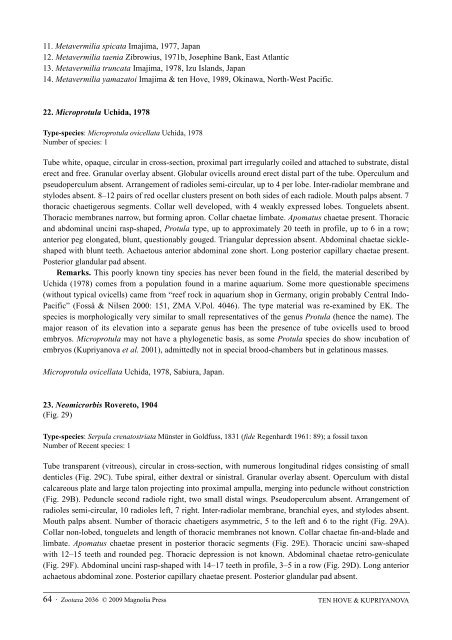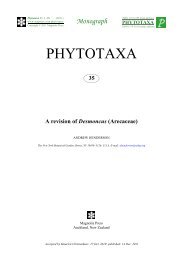Zootaxa, Taxonomy of Serpulidae (Annelida ... - Magnolia Press
Zootaxa, Taxonomy of Serpulidae (Annelida ... - Magnolia Press
Zootaxa, Taxonomy of Serpulidae (Annelida ... - Magnolia Press
You also want an ePaper? Increase the reach of your titles
YUMPU automatically turns print PDFs into web optimized ePapers that Google loves.
11. Metavermilia spicata Imajima, 1977, Japan<br />
12. Metavermilia taenia Zibrowius, 1971b, Josephine Bank, East Atlantic<br />
13. Metavermilia truncata Imajima, 1978, Izu Islands, Japan<br />
14. Metavermilia yamazatoi Imajima & ten Hove, 1989, Okinawa, North-West Pacific.<br />
22. Microprotula Uchida, 1978<br />
Type-species: Microprotula ovicellata Uchida, 1978<br />
Number <strong>of</strong> species: 1<br />
Tube white, opaque, circular in cross-section, proximal part irregularly coiled and attached to substrate, distal<br />
erect and free. Granular overlay absent. Globular ovicells around erect distal part <strong>of</strong> the tube. Operculum and<br />
pseudoperculum absent. Arrangement <strong>of</strong> radioles semi-circular, up to 4 per lobe. Inter-radiolar membrane and<br />
stylodes absent. 8–12 pairs <strong>of</strong> red ocellar clusters present on both sides <strong>of</strong> each radiole. Mouth palps absent. 7<br />
thoracic chaetigerous segments. Collar well developed, with 4 weakly expressed lobes. Tonguelets absent.<br />
Thoracic membranes narrow, but forming apron. Collar chaetae limbate. Apomatus chaetae present. Thoracic<br />
and abdominal uncini rasp-shaped, Protula type, up to approximately 20 teeth in pr<strong>of</strong>ile, up to 6 in a row;<br />
anterior peg elongated, blunt, questionably gouged. Triangular depression absent. Abdominal chaetae sickleshaped<br />
with blunt teeth. Achaetous anterior abdominal zone short. Long posterior capillary chaetae present.<br />
Posterior glandular pad absent.<br />
Remarks. This poorly known tiny species has never been found in the field, the material described by<br />
Uchida (1978) comes from a population found in a marine aquarium. Some more questionable specimens<br />
(without typical ovicells) came from “reef rock in aquarium shop in Germany, origin probably Central Indo-<br />
Pacific” (Fosså & Nilsen 2000: 151, ZMA V.Pol. 4046). The type material was re-examined by EK. The<br />
species is morphologically very similar to small representatives <strong>of</strong> the genus Protula (hence the name). The<br />
major reason <strong>of</strong> its elevation into a separate genus has been the presence <strong>of</strong> tube ovicells used to brood<br />
embryos. Microprotula may not have a phylogenetic basis, as some Protula species do show incubation <strong>of</strong><br />
embryos (Kupriyanova et al. 2001), admittedly not in special brood-chambers but in gelatinous masses.<br />
Microprotula ovicellata Uchida, 1978, Sabiura, Japan.<br />
23. Neomicrorbis Rovereto, 1904<br />
(Fig. 29)<br />
Type-species: Serpula crenatostriata Münster in Goldfuss, 1831 (fide Regenhardt 1961: 89); a fossil taxon<br />
Number <strong>of</strong> Recent species: 1<br />
Tube transparent (vitreous), circular in cross-section, with numerous longitudinal ridges consisting <strong>of</strong> small<br />
denticles (Fig. 29C). Tube spiral, either dextral or sinistral. Granular overlay absent. Operculum with distal<br />
calcareous plate and large talon projecting into proximal ampulla, merging into peduncle without constriction<br />
(Fig. 29B). Peduncle second radiole right, two small distal wings. Pseudoperculum absent. Arrangement <strong>of</strong><br />
radioles semi-circular, 10 radioles left, 7 right. Inter-radiolar membrane, branchial eyes, and stylodes absent.<br />
Mouth palps absent. Number <strong>of</strong> thoracic chaetigers asymmetric, 5 to the left and 6 to the right (Fig. 29A).<br />
Collar non-lobed, tonguelets and length <strong>of</strong> thoracic membranes not known. Collar chaetae fin-and-blade and<br />
limbate. Apomatus chaetae present in posterior thoracic segments (Fig. 29E). Thoracic uncini saw-shaped<br />
with 12–15 teeth and rounded peg. Thoracic depression is not known. Abdominal chaetae retro-geniculate<br />
(Fig. 29F). Abdominal uncini rasp-shaped with 14–17 teeth in pr<strong>of</strong>ile, 3–5 in a row (Fig. 29D). Long anterior<br />
achaetous abdominal zone. Posterior capillary chaetae present. Posterior glandular pad absent.<br />
64 · <strong>Zootaxa</strong> 2036 © 2009 <strong>Magnolia</strong> <strong>Press</strong><br />
TEN HOVE & KUPRIYANOVA
















